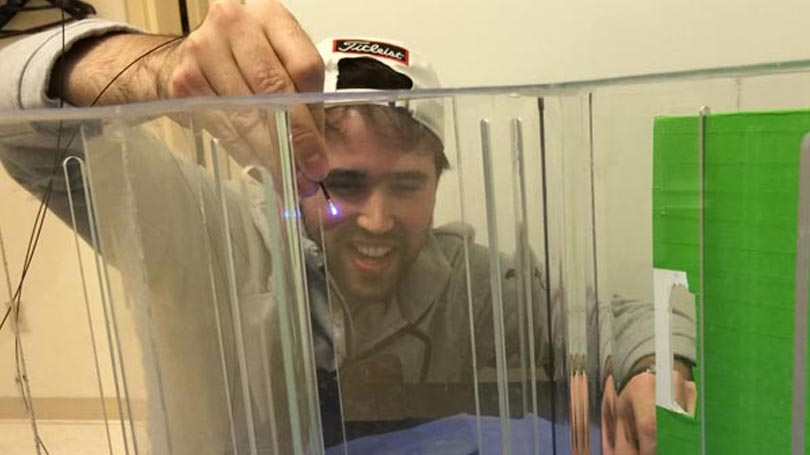
Adam Crego at work in his lab in the Psychological and Brain Sciences program
Adam Crego is a Cognitive Neuroscience graduate student in the Smith Lab in the Department of Psychological and Brain Sciences.
Habits have been the subject of scientific and medical attention for over a century due to their sheer ubiquity in behavior and the spectrum of healthy and unhealthy influences they have over people. Intuitively, habits have come to be understood in part as well-learned behaviors that are fast, fluid, consistent, and expressed in full once initiated. However, in some cases, habits can become detrimental to health when they are maladaptive and resistant to change.
In the brain, studies routinely implicate the basal ganglia, particularly the striatum and its input from cortex and dopamine, in controlling habits. I am particularly interested in how these neural networks are implicated in excessive habits including drug addiction, obsessive-compulsive spectrum disorders (OCD), and obesity. Our understanding of the neurobiology of habits has come from anatomical and lesion (and patient) studies that provide a basic sketch of habit circuits, and similarly from neural recording studies that have implicated specific second-by- second dynamics of neural activity. There is a vast chasm between these bodies of work; we do not know how habits arise from the fine-timescale dynamics of the brain. This issue is finally testable thanks to a new tool called optogenetics, which allows us to manipulate neural activity at the sub-second level with cell-type and pathway-type precision using lasers with specific wavelengths of light. The goal of my research is to control and monitor the striatum dynamics related to habits in an effort to (1) establish what neural patterns can make a habit artificially strong or can weaken a habit, and (2) how inputs (e.g., from cortex or dopamine) modulate those patterns as a circuit.
Through the generous Dartmouth Graduate Research Alumni Research Award, I was able to acquire the innovative animal behaviour tracking software called EthoVision XT by Noldus Inc. Combining this software with my plus-maze behaviour paradigm, I was able to manipulate the brain regions fundamentally responsible for habit acquisition through millisecond precision using optogenetics. EthoVision not only has allowed me to remove human error entirely, but also has permitted me to control, record, and direct habit gradients over the course of time. This Noldus software has aided in my research momentously, and I am now determined to take full profit of its potential in underpinning the formation, breaking, and even the overwriting of habits. This work could open up a range of applications, including in particular the possibility of normalizing behavior of animal models (e.g., of addiction or OCD) or even, potentially, aiding the treatment of human sufferers.